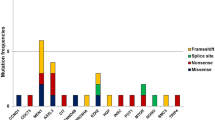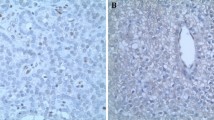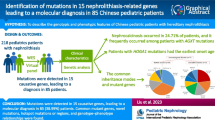Abstract
Purpose
Familial isolated hyperparathyroidism (FIHP) is a rare inherited disease accounting for 1% of all cases of primary hyperparathyroidism (PHPT). It is genetically heterogeneous being associated with mutations in different genes, including MEN1, CDC73, CASR, and recently GCM2. The aim of the study was to further investigate the molecular pathogenesis in Italian FIHP kindreds.
Methods
We used whole exome sequencing (WES) in the probands of seven unrelated FIHP kindreds. We carried out a separate family-based exome analysis in a large family characterized by the co-occurrence of PHPT with multiple tumors apparently unrelated to the disease. Selected variants were also screened in 18 additional FIHP kindreds. The clinical, biochemical, and pathological characteristics of the families were also investigated.
Results
Three different variants in GCM2 gene were found in two families, but only one (p.Tyr394Ser), already been shown to be pathogenic in vitro, segregated with the disease. Six probands carried seven heterozygous missense mutations segregating with the disease in the FAT3, PARK2, HDAC4, ITPR2 and TBCE genes. A genetic variant in the APC gene co-segregating with PHPT (p.Val530Ala) was detected in a family whose affected relatives had additional tumors, including colonic polyposis.
Conclusion
We confirm the role of GCM2 germline mutations in the pathogenesis of FIHP, although at a lower rate than in the previous WES study. Further studies are needed to establish the prevalence and the role in the predisposition to FIHP of the novel variants in additional genes.


Similar content being viewed by others
Change history
26 September 2019
Unfortunately, the 13th author name has been published incorrectly in the original publication.
26 September 2019
Unfortunately, the 13th author name has been published incorrectly in the original publication.
References
Brewer K, Costa-Guda J, Arnold A (2019) Molecular genetic insights into sporadic primary hyperparathyroidism. Endocr Relat Cancer 26:R53–R72. https://doi.org/10.1530/ERC-18-0304
Cardoso L, Stevenson M, Thakker RV (2017) Molecular genetics of syndromic and non-syndromic forms of parathyroid carcinoma. Hum Mutat 38:1621–1648. https://doi.org/10.1002/humu.23337
Marx SJ (2019) New concepts about familial isolated hyperparathyroidism. J Clin Endocrinol Metab. https://doi.org/10.1210/jc.2018-02789
Pontikides N, Karras S, Kaprara A et al (2014) Genetic basis of familial isolated hyperparathyroidism: a case series and a narrative review of the literature. J Bone Miner Metab 32:351–366. https://doi.org/10.1007/s00774-013-0551-9
Pardi E, Borsari S, Saponaro F et al (2017) Mutational and large deletion study of genes implicated in hereditary forms of primary hyperparathyroidism and correlation with clinical features. PLoS One 12:1–22. https://doi.org/10.1371/journal.pone.0186485
Guan B, Welch JM, Sapp JC et al (2016) GCM2-activating mutations in familial isolated hyperparathyroidism. Am J Hum Genet 99:1034–1044. https://doi.org/10.1016/j.ajhg.2016.08.018
Günther T, Chen Z-F, Kim J et al (2000) Genetic ablation of parathyroid glands reveals another source of parathyroid hormone. Nature 406:199–203. https://doi.org/10.1038/35018111
Guan B, Welch JM, Vemulapalli M et al (2017) Ethnicity of patients with germline GCM2 -activating variants and primary hyperparathyroidism. J Endocr Soc 1:488–499. https://doi.org/10.1210/js.2017-00043
Cetani F, Pardi E, Giovannetti A et al (2002) Genetic analysis of the MEN1 gene and HPRT2 locus in two Italian kindreds with familial isolated hyperparathyroidism. Clin Endocrinol (Oxf) 56:457–464. https://doi.org/10.1046/j.1365-2265.2002.01502.x
Guo Y, Ding X, Shen Y et al (2015) SeqMule: automated pipeline for analysis of human exome/genome sequencing data. Sci Rep 5:1–10. https://doi.org/10.1038/srep14283
Quang D, Chen Y, Xie X (2015) DANN: a deep learning approach for annotating the pathogenicity of genetic variants. Bioinformatics 31:761–763. https://doi.org/10.1093/bioinformatics/btu703
Kopanos C, Tsiolkas V, Kouris A et al (2019) VarSome: the human genomic variant search engine. Bioinformatics 35:1978–1980. https://doi.org/10.1093/bioinformatics/bty897
Rouillard AD, Gundersen GW, Fernandez NF et al (2016) The harmonizome: a collection of processed datasets gathered to serve and mine knowledge about genes and proteins. Database 2016:1–16. https://doi.org/10.1093/database/baw100
Pandya C, Uzilov AV, Bellizzi J et al (2017) Genomic profiling reveals mutational landscape in parathyroid carcinomas. Jci Insight 2:1–14. https://doi.org/10.1172/jci.insight.92061
Okur V, Chung WK (2017) The impact of hereditary cancer gene panels on clinical care and lessons learned. Mol Case Stud 3:1–15. https://doi.org/10.1101/mcs.a002154
Ponz de Leon M, Urso E, Pucciarelli S et al (2013) Clinical and molecular features of attenuated adenomatous polyposis in northern Italy. Tech Coloproctol 17:79–87. https://doi.org/10.1007/s10151-012-0887-5
Ding C, Buckingham B, Levine MA et al (2001) Familial isolated hypoparathyroidism caused by a mutation in the gene for the transcription factor GCMB. J Clin Invest 108:1215–1220. https://doi.org/10.1172/JCI200113180.Introduction
Riccardi A, Aspir T, Shen L et al (2019) Analysis of activating GCM2 sequence variants in sporadic parathyroid adenomas. J Clin Endocrinol Metab 104:1948–1952. https://doi.org/10.1210/jc.2018-02517
El Lakis M, Nockel P, Guan B et al (2018) Familial isolated primary hyperparathyroidism associated with germline GCM2 mutations is more aggressive and has a lesser rate of biochemical cure. Surgery 163:31–34. https://doi.org/10.1016/j.surg.2017.04.027
Maret A, Ding C, Kornfield SL, Levine MA (2018) Analysis of the GCM2 gene in isolated hypoparathyroidism: a molecular and biochemical study. J Clin Endocrinol Metab 93:1426–1432. https://doi.org/10.1210/jc.2007-1783
Parvari R, Diaz A, Hershkovitz E (2007) Parathyroid development and the role of tubulin chaperone e. Horm Res 67:12–21. https://doi.org/10.1159/000095944
Fiala O, Zahorakova D, Pospisilova L et al (2014) Parkin (PARK 2) mutations are rare in czech patients with early-onset parkinson’ s disease. PLOS One 9:1–6. https://doi.org/10.1371/journal.pone.0107585
Xiong D, Wang Y, Kupert E et al (2015) A recurrent mutation in PARK2 is associated with familial lung cancer. Am J Hum Genet 96:301–308. https://doi.org/10.1016/j.ajhg.2014.12.016
Hu H, Kannengiesser C, Lesage S et al (2016) PARKIN inactivation links parkinson’ s disease to melanoma. JNCI J Natl Cancer Inst 108:1–8. https://doi.org/10.1093/jnci/djv340
Kasten M, Hartmann C, Hampf J et al (2018) Genotype-phenotype relations for the parkinson’ s disease genes parkin, PINK1, DJ1: MDSGene systematic review. Mov Disord 33:730–741. https://doi.org/10.1002/mds.27352
Gong Y, Zack T, Morris L et al (2014) Pan-cancer genetic analysis identifies PARK2 as a master regulator of G1/S cyclins Yongxing. Nat Genet 46:588–594. https://doi.org/10.1038/ng.2981.Pan-cancer
Bartek J, Hodn Z (2014) PARK2 orchestrates cyclins to avoid cancer. Nat Genet 46:527–528. https://doi.org/10.1038/ng.2992
Arnold A (2016) Major molecular genetic drivers in sporadic primary hyperparathyroidism. Trans Am Clin Climatol Assoc 127:235–244
Poulogiannis G, Mcintyre RE, Dimitriadi M et al (2010) PARK2 deletions occur frequently in sporadic colorectal cancer and accelerate adenoma development in Apc mutant mice. Proc Natl Acad Sci 107:15145–15150. https://doi.org/10.1073/pnas.1009941107
Ameratunga R, Woon ST, Bryant VL et al (2018) Clinical implications of digenic inheritance and epistasis in primary immunodeficiency disorders. Front Immunol 8:1–8. https://doi.org/10.3389/fimmu.2017.01965
Parra M (2015) Class IIa HDACs—new insights into their functions in physiology and pathology. FEBS J 282:1736–1744. https://doi.org/10.1111/febs.13061
Di Giorgio E, Clocchiatti A, Piccinin S et al (2013) MEF2 is a converging hub for histone deacetylase 4 and phosphatidylinositol 3-kinase/Akt-induced transformation. Mol Cell Biol 33:4473–4491. https://doi.org/10.1128/MCB.01050-13
Wiel C, Lallet-Daher H, Gitenay D et al (2014) Endoplasmic reticulum calcium release through ITPR2 channels leads to mitochondrial calcium accumulation and senescence. Nat Commun 5:3792. https://doi.org/10.1038/ncomms4792
Aretz S, Vasen HFA, Olschwang S (2014) Clinical utility gene card for: familial adenomatous polyposis (FAP) and attenuated FAP (AFAP)—update 2014. Eur J Hum Genet 23:1–4. https://doi.org/10.1038/ejhg.2014.193
Kerr SE, Thomas CB, Thibodeau SN et al (2013) APC germline mutations in individuals being evaluated for familial adenomatous polyposis a review of the mayo clinic experience with 1591 consecutive tests. J Mol Diagnostics 15:31–43. https://doi.org/10.1016/j.jmoldx.2012.07.005
Breitman M, Zilberberg A, Caspi M, Rosin-arbesfeld R (2008) The armadillo repeat domain of the APC tumor suppressor protein interacts with striatin family members. Biochim Biophys Acta 1783:1792–1802. https://doi.org/10.1016/j.bbamcr.2008.04.017
Crist RC, Roth JJ, Baran AA et al (2010) The armadillo repeat domain of Apc suppresses intestinal tumorigenesis. Mamm Genome 21:450–457. https://doi.org/10.1007/s00335-010-9288-0
Sakai Y, Koizumi K, Sugitani I et al (2002) Familial adenomatous polyposis associated with multiple endocrine neoplasia type 1-related tumors and thyroid carcinoma. Am J Surg Pathol 26:103–110
Uchino S, Ishikawa H, Miyauchi A et al (2016) Age- and gender-specific risk of thyroid cancer in patients with familial adenomatous polyposis. J Clin Endocrinol Metab 101:4611–4617. https://doi.org/10.1210/jc.2016-2043
Resta N, Stella A, Susca F et al (2001) Nine novel APC mutations in Italian FAP patients. Hum Mutat 415:1–5
Scott R, Taeschner W, Heinimann K et al (1997) Association of extracolonic manifestations of familial adenomatous polyposis with acetylation phenotype in a large FAP kindred. Eur J Hum Genet 5:43–49
Soravia C, Sugg SL, Berk T et al (1999) Familial adenomatous polyposis-associated thyroid cancer a clinical, pathological, and molecular genetics study. Am J Pathol 154:127–135
Mali P, Muduganti S, Enwezor C (2014) Rare case of non-Hodgkin’s lymphoma in a patient with multiple hyperplastic colon polyps. Case Rep Intern Med 2:83–85. https://doi.org/10.5430/crim.v2n1p83
Svedlund J, Aurén M, Sundström M et al (2010) Aberrant WNT/b -catenin signaling in parathyroid carcinoma. Mol Cancer 9:294. https://doi.org/10.1186/1476-4598-9-294
Kasaian K, Wiseman SM, Thiessen N et al (2013) Complete genomic landscape of a recurring sporadic parathyroid carcinoma. J Pathol 230:249–260. https://doi.org/10.1002/path.4203
Clarke CN, Katsonis P, Hsu T et al (2018) Comprehensive genomic characterization of parathyroid cancer identifies novel candidate driver mutations & core pathways. J Endocr Soc. https://doi.org/10.1210/js.2018-00043
Cui M, Hu Y, Bi Y et al (2019) Preliminary exploration of potential molecular therapeutic targets in recurrent and metastatic parathyroid carcinomas. Int J Cancer 144:525–532. https://doi.org/10.1002/ijc.31948
Talseth-Palmer BA (2017) The genetic basis of colonic adenomatous polyposis syndromes. Hered Cancer Clin Pract 15:1–7. https://doi.org/10.1186/s13053-017-0065-x
Cetta F (2015) FAP associated papillary thyroid carcinoma: a peculiar subtype of familial nonmedullary thyroid cancer. Patholog Res Int. https://doi.org/10.1155/2015/309348
Groen RWJ, Oud MECM, Schilder-Tol EJM et al (2008) Illegitimate WNT pathway activation by β-catenin mutation or autocrine stimulation in T-cell malignancies. Cancer Res 68:6969–6977. https://doi.org/10.1158/0008-5472.CAN-08-1322
Deltas C (2018) Digenic inheritance and genetic modifiers. Clin Genet 93:429–438. https://doi.org/10.1111/cge.13150
Acknowledgements
The authors thank the families involved in this study for their participation.
Funding
This work was supported by Progetti di Ricerca di Ateneo (PRA)—2015—of the University of Pisa (C.M.).
Author information
Authors and Affiliations
Contributions
FC and EP contributed equally to this report. Conceptualization and design of the experiments: FC, EP, PA, MAC, and CMM. Patients managing: FC, FS, LM, MA, AO, and CM. Collection and histological examination of tissue samples: LT. Genetic and whole exome sequencing analyses: EP, PA, SB, PC, MLF, FL, and CMM. Analysis of whole exome sequencing data: PA and EP. Contribution to the interpretation of the results: FC, EP, SB, and CMM. Drafting of the manuscript: FC, EP, PA, and SB. Critical revision of the article: FC, EP, PA, FS, SB, CMM, and CM. All authors read and approved the final manuscript.
Corresponding author
Ethics declarations
Conflict of interest
On behalf of all authors, the corresponding author states that there is no conflict of interest.
Ethical approval
The study was reviewed and approved by the University Hospital of Pisa Ethics Committee, and in accordance with the 1964 Helsinki declaration and its later amendments or comparable ethical standards.
Informed consent
Informed consent was obtained from all individual participants included in the study.
Additional information
Publisher's Note
Springer Nature remains neutral with regard to jurisdictional claims in published maps and institutional affiliations.
Electronic supplementary material
Below is the link to the electronic supplementary material.
Rights and permissions
About this article
Cite this article
Cetani, F., Pardi, E., Aretini, P. et al. Whole exome sequencing in familial isolated primary hyperparathyroidism. J Endocrinol Invest 43, 231–245 (2020). https://doi.org/10.1007/s40618-019-01107-5
Received:
Accepted:
Published:
Issue Date:
DOI: https://doi.org/10.1007/s40618-019-01107-5




